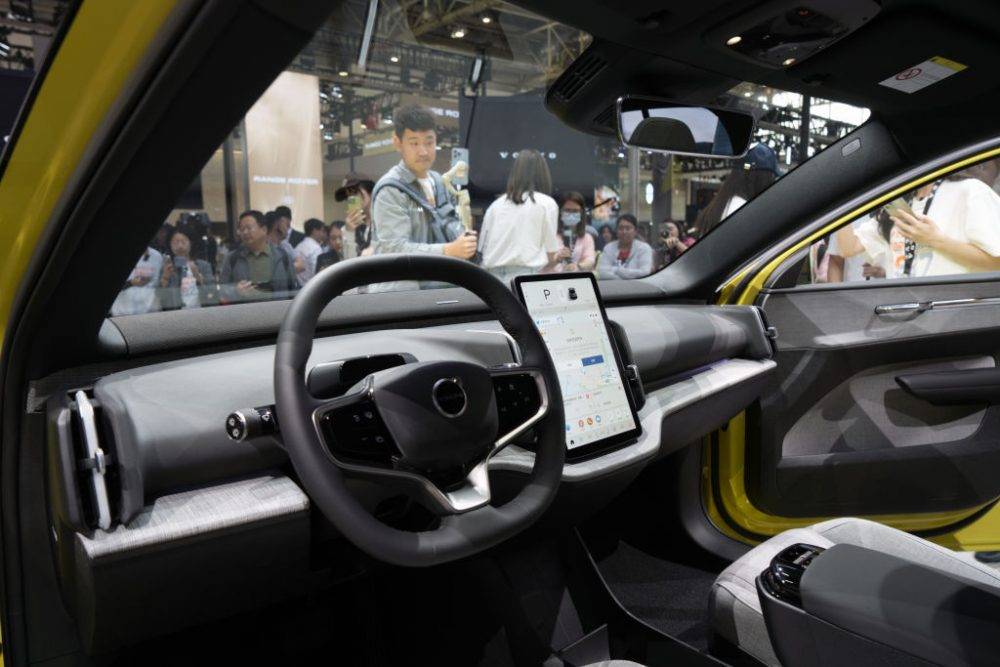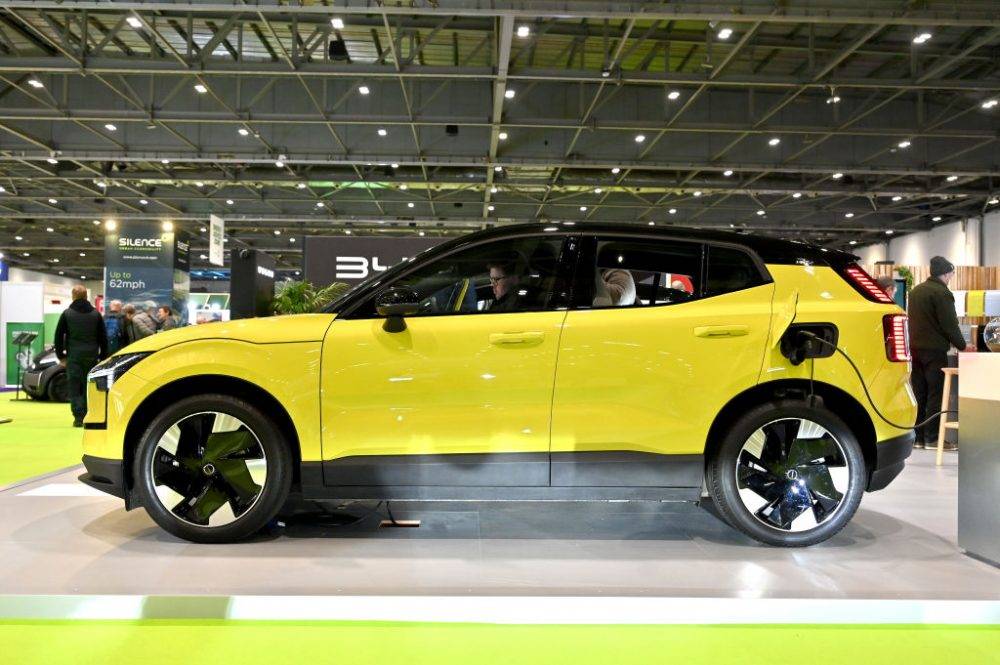Futuristic: The Volvo EX30 looks like a concept and goes from 0-100 km/h in just 3.6 seconds. (Photo by John Keeble/Getty Images)
If there was ever a car to embody the word “futuristic”, it would be the Volvo EX30.
A longing glance at the front of the vehicle elicits the same reaction we felt with the Audi’s concept RSQ when we first saw it in the 2004 blockbuster I, Robot.
Because of the amount of technology that new cars have, I always figure it out before I drive the car, and luckily I did with this one. There is a 12.3 inch infotainment system which controls all aspects of the vehicle. It even goes as far as opening the glovebox for you.
While it can be seen as a positive that everything is in one place, I felt slightly concerned that the lack of buttons might distract me while driving.
Things like turning the AC on and off were a slight inconvenience, particularly as the car scolds you about keeping your eyes on the road every time you glance at the infotainment system.
But that is where the inconvenience with the car itself stops. Once you are in and driving, you are swept up in a dream.
The Volvo EX30 is available in three derivatives. First, there is the core single motor, which offers 200 kilowatts of power and 343Nm of torque with a 51 kilowatt-hour battery pack. The range Volvo claims on this model is 344km.
Then, there is the single motor extended range, which is slightly quicker than the base model, and gives you an additional 130km of range on the car as it carries a 69kWh battery.
Then we have the twin motor performance model which I was lucky enough to drive. This derivative offers the same 69kWh battery pack but an insane amount of speed. It has 315kW of power and 510Nm of torque. The range claimed on this model is 460km but I only got up to 380km on a full charge.
But here’s the fun part about the latter model. It goes from 0 to 100km/h in 3.6 seconds. To put that into perspective, that borders on the same acceleration performance as cars such as the Porsche 911 and BMW M3.
When I tested that, there was no noise, just an amazing kick that pushed your head back and, before I knew it, I was at 120km/h.
In fact, I almost felt like pulling up next to those loud M3s at the traffic lights and accelerating away from them to remind them of the saying “silence is golden”.
That is particularly true when it comes to the Volvo EX30. You don’t hear the car, thanks to the electric motor. The vehicle switches on as soon as you enter it and to the surprise of many, it’s already moving.
The interior was comfortable and spacious in the front, but very tight at the back. Whenever I had passengers in the car, I had to adjust the front seat into an uncomfortable driving position to give passengers enough space to stretch their legs.
While the vehicle does fit into the crossover category, I was not expecting it to be spacious. Volvo has tagged it as its smallest and quickest car, so I was not too disappointed at the space issues.
The highlight of the interior had to be the panoramic glass roof that gave the cabin a majestic aura. Coupled with the ambient lighting that is nature-themed, it felt simple and futuristic at the same time.
I took the car on a number of routes from Springs. It was Johannesburg on Friday, Bedfordview on Sunday and then a long trip to Pretoria on Monday.
This is where I faced my toughest challenge with the car, and in all honesty, it had nothing to do with the car.
I left Springs on Friday with the car on 70% battery, which meant that I had just over 200km of range. I was not worried about charging, because from the research I had done, there were an abundance of charging stations in Johannesburg.
I thought that I would grab lunch and charge the car at Melrose Arch, where I first had to drive through the entire underground parking lot and ask about five people where the charger was before I found it.
 The interior of the Volvo EX30. Photographer: Qilai Shen/Bloomberg via Getty Images
The interior of the Volvo EX30. Photographer: Qilai Shen/Bloomberg via Getty Images
Once I found it, I plugged in the charger and nothing happened. City Power had failed me. Melrose Arch had no electricity.
Still optimistic, I looked for the next charging station. It was not far at all – a Nissan dealership on Corlette drive. When I got there, the charger was not the same type and did not fit into the car.
Still optimistic, I decided to go to Thrupps Centre in Illovo and grab the next charging station. On arrival, I saw that this charging station required that you bring your own cable, which I had. I plugged in, scanned my card and the car estimated that it would charge from 30% to 100% in 15 hours.
I’m usually patient, but not that patient.
The optimism was slowly running out, but I decided that I would try one last place and that was the Sasol garage on Jan Smuts Avenue in Rosebank — the same garage where The Pantry is.
I got there and saw a hulking Mercedes EQ charger that looked powerful. I was immensely relieved when I plugged it in and the estimated charge time to 100% was under an hour.
That was when I understood that charging your electric vehicle is one thing, but finding the right type of charger is the more important thing.
Most electric cars now have two charging ports in the same area. The first being a type 2 port, which is slow alternating current charging and the second being a CCS port which is fast direct current charging.
Luckily, when you search for nearby chargers on Google Maps, you will be told if the charger is a type 2 or CCS charger.
 Challenges: Finding charging stations in South Africa for a fully electric vehicle is an issue. (Photo by John Keeble/Getty Images)
Challenges: Finding charging stations in South Africa for a fully electric vehicle is an issue. (Photo by John Keeble/Getty Images)
For every trip I had to do after this, I made sure that I did my research before I left the house. But this also means leaving 45 minutes earlier so that you can charge the car.
On Sunday, I managed to grab a fast charger in Bedford Centre and on Tuesday on my way to Pretoria, the Highveld Engen in Tembisa on the R21 also had two fast chargers.
While your car might be faster than a petrol car, it will still take you longer to do trips that are further away from home, so I learnt that with an electric car, you need to leave early, take snacks or buy a coffee while you wait for the car to charge. In other words, you need to have a very easy-going lifestyle.
But it is still stressful, because if you live away from the city, the country simply does not have enough charging stations. You can get an adapter for the type 2 charger and connect it to a wall socket at home, but then you are looking at a full day of charging before the battery has reached 100%.
Volvo claims that it wants to be fully electric by 2030 and other brands will follow suit very soon. With more electric vehicles like Ora and BYD entering the country and only 400 charging points in South Africa, there is much work to be done if the EV market is going to be successful and if the country wants to encourage consumers to use EVs.
The United Kingdom has over 60 000 charging points and the United States has over 160 000.
However, when it came to the car itself, I found myself for the first time developing an attachment to a car that I was reviewing. If this is the beginning of the future, can it please come sooner?
Models and prices
Core Single Motor derivative (R775 900)
Single Motor Extended Range – available in Plus (R865 900) and Ultra (R965 900)
Twin Motor Performance powertrain – also offered in conjunction with the Plus (R935 900) and Ultra (R995 900) trim levels